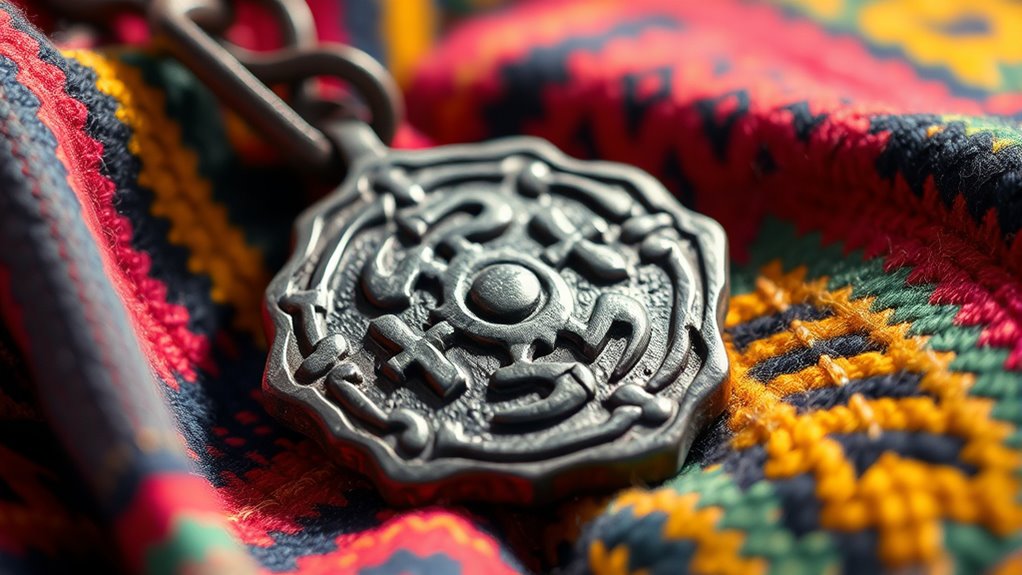You might find that iron has long been seen as a powerful protector against evil spirits and curses in folklore. Historically, people believed iron could absorb or deflect harmful energies and supernatural harm, using objects like nails, horseshoes, or charms to guard their homes and themselves. These beliefs have persisted, with iron symbols often carried or hung for good luck and safety. If you stay curious, you’ll discover more about how these traditions continue to influence modern superstition.
Key Takeaways
- Iron has historically been believed to absorb or deflect harmful energies and evil spirits, serving as a protective barrier.
- Common folk objects like horseshoes and iron nails are used to ward off evil and bring good luck.
- Iron is thought to break spells, nullify curses, and ward off witchcraft and black magic.
- Cultural rituals incorporate iron as a natural safeguard, embedding its protective qualities into traditions and symbols.
- Modern folklore continues to associate iron charms and symbols with safety, good luck, and spiritual protection.

Have you ever wondered why iron has long been associated with protective powers in folklore? Throughout history, people have believed that iron possesses unique qualities that ward off evil spirits, misfortune, and illness. This belief isn’t recent; it stretches back centuries to medieval times when iron objects, especially medieval iron amulets, were worn or carried for protection. These amulets, often shaped into crosses, horseshoes, or other symbols, were thought to act as barriers against malevolent forces. In those days, folk beliefs about iron were deeply ingrained in daily life, and many thought that iron had the power to repel supernatural harm simply by its presence.
Iron has long been believed to ward off evil spirits and protect against harm.
In medieval societies, iron was considered a powerful material because of its association with strength and durability. People believed that iron could absorb or deflect harmful energies, making it a natural choice for amulets and charms. These medieval iron amulets weren’t just decorative; they were imbued with spiritual significance and were often blessed by clergy to enhance their protective qualities. The idea was that iron, being a hard and unyielding metal, could imprison or contain evil spirits, preventing them from causing harm to the wearer or their household. Folk beliefs about iron often extended to everyday objects—nails, horseshoes, and iron tools—each thought to possess protective properties when placed in or around homes.
The superstition around iron’s protective qualities was also linked to its perceived ability to ward off witchcraft and black magic. Many believed that iron could break spells or nullify curses. For example, hanging a horseshoe above your door, made of iron, was a widespread practice for good luck and protection. People thought that the iron’s magnetic properties could attract positive energies and repel negative ones. Additionally, iron was considered a material that could dispel evil spirits, which is why knocking on iron objects or carrying small iron charms was common in folk practices.
These beliefs persisted for centuries, blending with local customs and religious practices. Folk traditions often incorporated iron into rituals, believing it to be a natural safeguard against unseen dangers. Even today, many still hold onto the idea that iron, especially in the form of charms or symbols, can provide a layer of protection. The historical significance of medieval iron amulets and folk beliefs about iron demonstrates how deeply ingrained the idea of iron as a protective force has been across cultures and eras. Whether as a tangible object or a symbolic talisman, iron’s reputation as a guardian continues to influence modern folklore and superstition.
Frequently Asked Questions
How Is Iron Believed to Ward off Evil Spirits?
Iron warding off evil spirits is a common belief rooted in folklore. You might carry or wear protective amulets made of iron because it’s thought to repel negative energies and malevolent entities. When you keep iron objects nearby, they create a barrier that prevents spirits from entering your space. This tradition emphasizes the powerful protective qualities of iron, which has been used for centuries to keep evil at bay and safeguard your surroundings.
Are There Cultural Differences in Iron Folklore Protections Worldwide?
Imagine a tapestry of folklore diversity where iron’s protective powers vary across cultures. You’ll find that in some regions, iron wards off negative energies, while in others, it symbolizes strength or protection from spirits. These cultural variations highlight how beliefs shape protective practices worldwide. You see, while the core idea remains, the symbolism and methods differ, reflecting unique traditions and histories that influence how communities embrace iron’s mystical qualities.
Can Iron Objects Be Used for Modern Spiritual or Protective Practices?
Yes, you can use iron objects in modern spiritual or protective practices because of their magnetic properties and historical symbolism. Iron is believed to absorb negative energy and ward off evil spirits, making it a powerful tool in various traditions. You might keep an iron talisman or place iron objects around your space to harness these protective qualities, blending ancient symbolism with contemporary beliefs for personal spiritual safety.
What Historical Origins Explain Iron’s Protective Symbolism?
You see, iron’s protective symbolism dates back to medieval armor, where it represented strength and defense. People also used iron amulets, believing they could ward off evil spirits. These beliefs likely stem from iron’s durability and connection to protection, making it a powerful symbol across cultures. Its historical use in armor and amulets reinforced the idea that iron could shield individuals from harm and negative energies.
Are There Scientific Explanations for Iron’s Folkloric Protective Properties?
You might find it fascinating that scientific explanations for iron’s folkloric protective properties include its magnetic properties and role in iron metabolism. For example, iron’s magnetic field can influence nearby biological processes, potentially affecting immunity. While folklore attributes protective powers to iron, studies suggest these effects may stem from its biological importance and magnetic influences, providing a plausible scientific basis for its perceived protective qualities.
Conclusion
So, next time you see iron, remember it’s not just metal—it’s the ultimate guardian that could stop a thousand curses, ward off evil spirits, and keep darkness at bay. You hold in your hands a mighty shield more powerful than any spell or charm. Iron’s magic is unstoppable, a force so fierce it could turn back the worst of nightmares, making it your strongest, most unbeatable protector in the entire universe.









